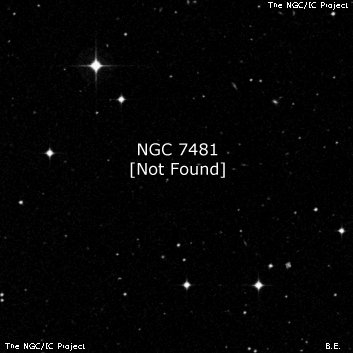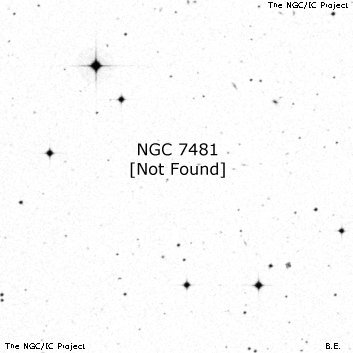NGC/IC Project Restoration Effort
(This is a very very beta version)
NGC7481


Basic Information
Location and Magnitude
Right Ascension: 23:5:51.0
Declination: -19:56:24
Constellation: AQR
Visual Magnitude:
Historic Information
Discoverer: Stone
Year of discovery: 1886
Discovery aperture: 26.3
Observational
Summary description: vF, vS, R, gbM
Sub-type: NF
Corwin's Notes
=====
NGC 7481 is also lost. Described by Ormond Stone as being of magnitude 14.0,
very small, round, and gradually brighter in the middle, it is certainly not
the galaxy that ESO chose as a possible candidate. That is too faint,
elongated, has a brighter star superposed just east, and an equally bright
companion galaxy within an arcminute to the northeast.
A search of the POSS1 prints around the nominal position reveals no galaxy
matching Stone's description. Since there is no sketch, and Stone mentions
no nearby stars, we probably won't be able to recover this object.
As with NGC 7471, I have not checked for large digit errors.
-----
And, as with NGC 7471, I've now checked for digit errors. This turned up a
couple of candidates: 1) NGC 7365, and 2) one or another of the brighter
galaxies in Abell 2538 (at 23 08.6 -19 53 for J2000). Of these, NGC 7365 is
the more likely choice as its description -- by Leavenworth using the same
telescope as Stone -- is nearly identical. The declinations of the objects
are indeed identical as published in the AJ paper, though the RA's are
different by 21 minutes of time. The Abell cluster galaxies are much fainter,
enough so that I doubt that they could be swept up by even LdR's Leviathan.
So, I've put NGC 7365 in the table as a possible identification for this
object. Is it the correct object? I frankly doubt it, but it is all I've
been able to find.



